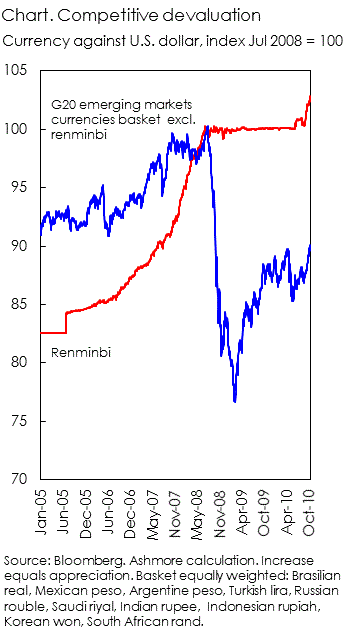"Currency wars"
29 September 2010
Ousmène Mandeng, Ashmore Investment Management
Brazilian finance minister Mantega’s warning on September 27 of a global currency war is only another indication that exchange rates are seriously out of whack. The foreign exchange market intervention by the ministry of finance of Japan on September 15 earlier hinted that exchange rates have moved to the top of policy makers’ concerns but could also be interpreted as an act of desperation or frustration that there is no common position on exchange rates. The U.S. and China also continue to squabble about the renminbi. Switzerland has been quietly but aggressively intervening and yet the franc has reached a new high against the dollar on September 28. These are strong hints that the threat of sustained currency turmoil is real.
Japan has had a long tradition of foreign exchange interventions though this was the first after a 6½-year pause. On September 27, Bank of Japan governor Shirakawa indicated that there may be more to come; he justified intervention that a stronger yen will adversely affect business sentiment and the outlook for Japan’s economy. From January 2003 through March 2004, the last batch of almost uninterrupted interventions, the ministry of finance bought the equivalent of US$353 billion by conducting dollar and some euro purchases. During 2000-04, the yen depreciated from a trough of JPY 103 in March 2000 to JPY135 in February 2002 to JPY104 in April 2004. This is a spectacular roller-coaster and there is little to suggest that fundamentals could explain such gyrations. Japan now holds foreign exchange reserves of US$1,020 billion.
The biggest foreign exchange intervener is of course China. China’s non- gold reserves stand at US$2,454 billion. This has caused repeated animosities but in itself may not be a problem if domestic prices and wages are al- lowed to adjust. However, though China intervened massively, its exchange rate appreciated faster than its competitors and since the Lehman Brothers’ collapse the renminbi has remained among the most appreciated currencies against the dollar. The increasing gap between the renminbi and other key emerging markets currencies must cause some unease in Beijing. The devaluation gap matters in third markets and China may be concerned that it could lose market share due to undue competitive devaluations (Chart).
Brazil is also among the major interveners. The central bank has accumu- lated US$4.3 billion per month in international reserves since May 2009 and foreign exchange reserves now stand at a record US$272 billion. The real, for that reason, is still more depreciated against the dollar compared with its pre-crisis levels. As Brazil has increasingly diversified its exports towards Asia, its biggest export destination is now China, its exchange rate concerns have shifted. Competing with the Asian currencies may put additional pres- sure on preventing the real from appreciating more.
Switzerland has been one of the most aggressive interveners. The Swiss National Bank is now among the 10 largest central banks by international reserves holdings and has since May 2009 increased its non-gold reserves more than four-fold to US$219 billion. The franc has appreciated to a new high of CHF0.98 on September 28 from CHF1.22 in November 2008. These significant movements underscore substantial uncertainty in major foreign exchange markets.
The case for foreign exchange market intervention is a strong one. The volatility in foreign exchange markets and now the prospects of sustained interventions in the main currency markets and an array of unilateral and uncoordinated actions risks being increasingly destabilizing. Simple interventions may also not work as underlying structural trends are likely to be dominant in particular when done unilaterally and uncoordinated. As the G20 is preparing for its November summit, these considerations should feature on its work programme prominently and fittingly, 25 years after the Plaza accord. It would be the clearest indication yet that the G20 is serious about the interna- tional economy. Exchange rate issues should be brought forward to establish a framework sufficient to arrest market concerns about persistent exchange rate misalignments. This must rest in a coordinated depreciation of the dollar and appreciation of emerging markets currencies.
